BSc Business Management BMP3004: Understanding Motivation at Work
VerifiedAdded on 2023/06/14
|8
|1949
|147
Report
AI Summary
This report provides an analysis of the factors that motivate employees in the workplace, drawing upon Maslow's hierarchy of needs to explain intrinsic and extrinsic motivation. It identifies key motivators such as salary, promotion opportunities, and a positive work environment. The report also evaluates the positive factors employees experience, including problem-solving opportunities and skill development, alongside negative factors like lack of motivation and workplace disputes. Strategies for coping with these negative factors, such as motivational practices and effective communication, are discussed, emphasizing their importance in fostering a productive and positive work culture. The document concludes that a motivated workforce is crucial for achieving organizational goals and highlights the significance of addressing both positive and negative influences on employee performance.
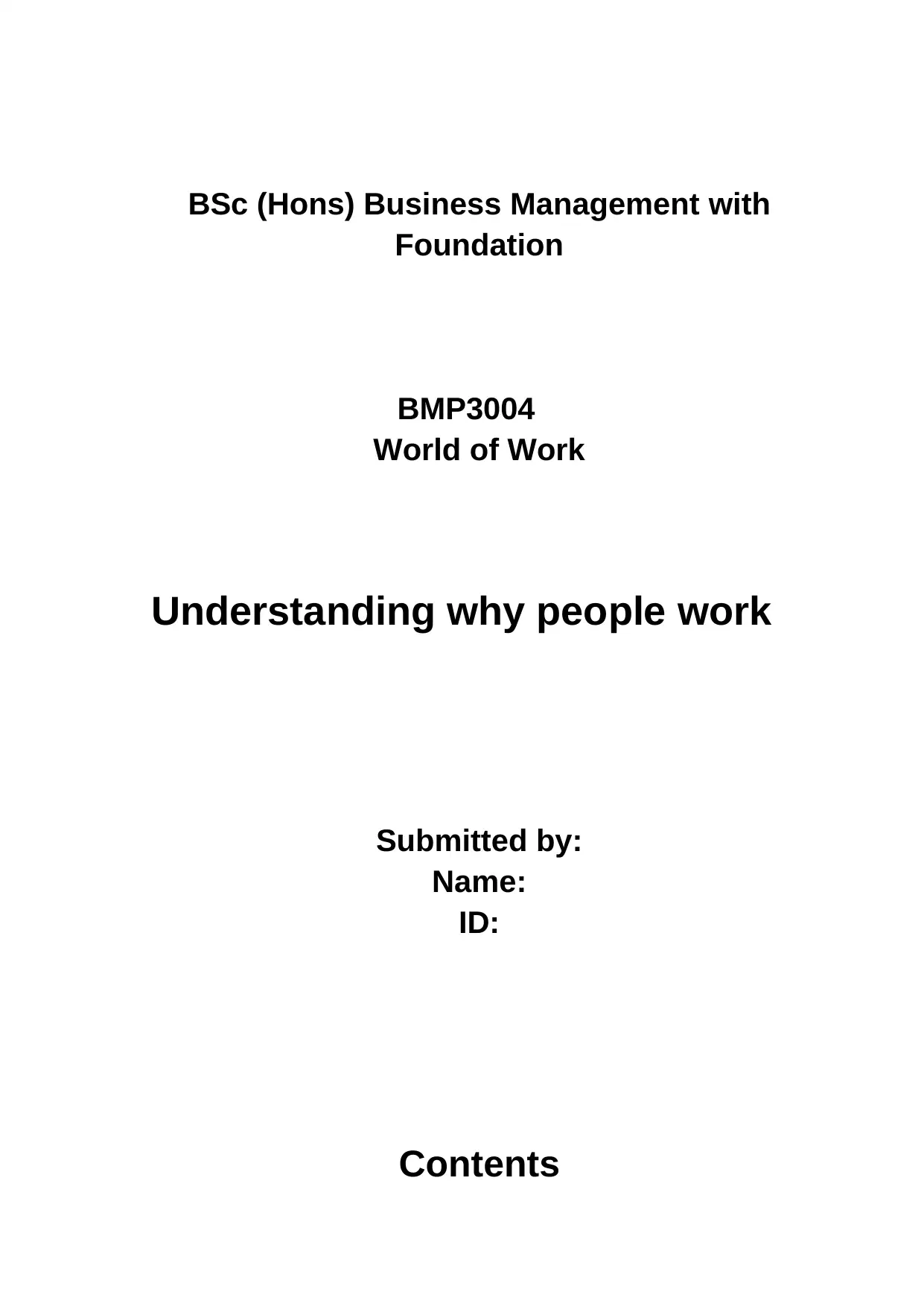
BSc (Hons) Business Management with
Foundation
BMP3004
World of Work
Understanding why people work
Submitted by:
Name:
ID:
Contents
Foundation
BMP3004
World of Work
Understanding why people work
Submitted by:
Name:
ID:
Contents
Paraphrase This Document
Need a fresh take? Get an instant paraphrase of this document with our AI Paraphraser
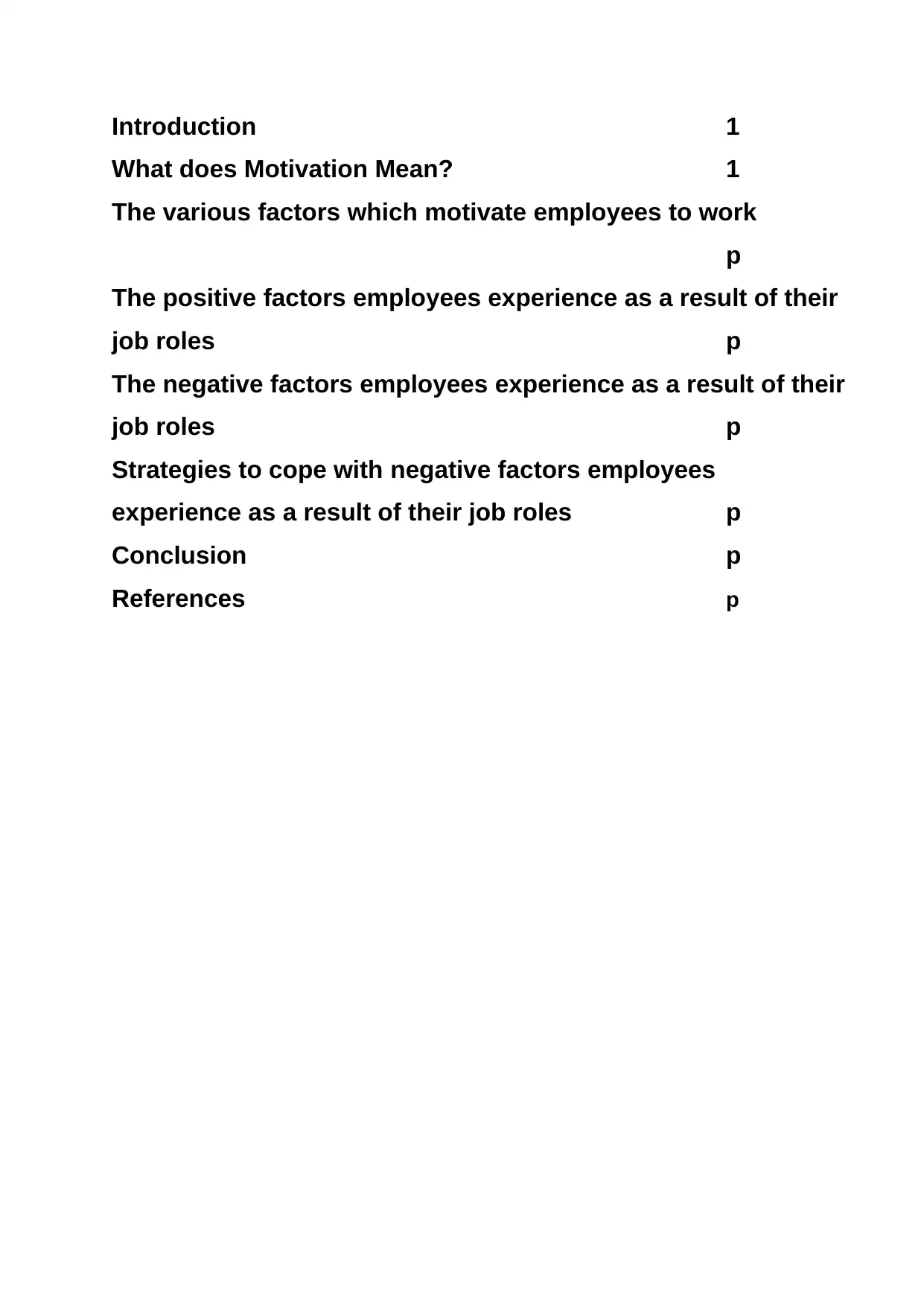
Introduction 1
What does Motivation Mean? 1
The various factors which motivate employees to work
p
The positive factors employees experience as a result of their
job roles p
The negative factors employees experience as a result of their
job roles p
Strategies to cope with negative factors employees
experience as a result of their job roles p
Conclusion p
References p
What does Motivation Mean? 1
The various factors which motivate employees to work
p
The positive factors employees experience as a result of their
job roles p
The negative factors employees experience as a result of their
job roles p
Strategies to cope with negative factors employees
experience as a result of their job roles p
Conclusion p
References p
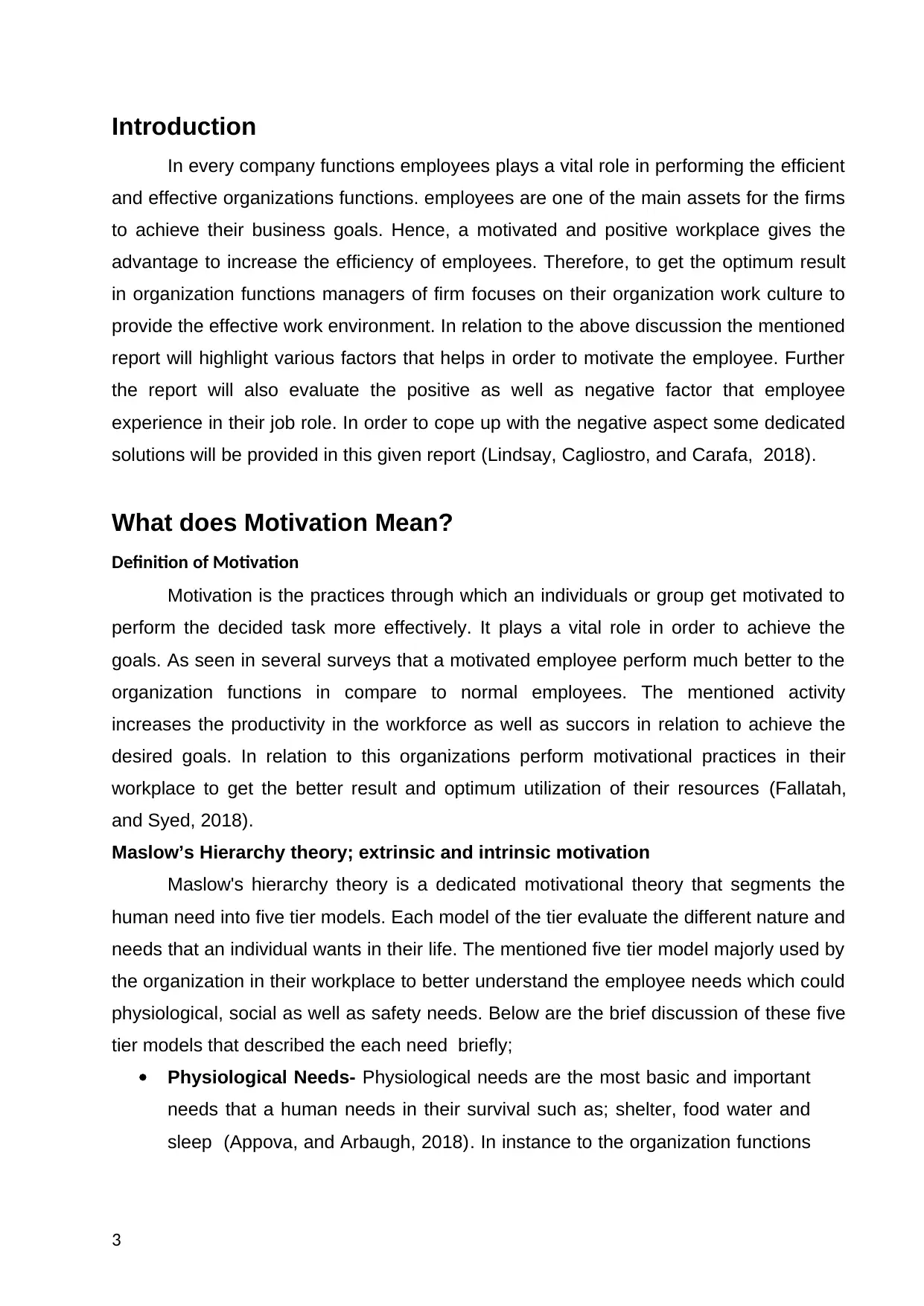
Introduction
In every company functions employees plays a vital role in performing the efficient
and effective organizations functions. employees are one of the main assets for the firms
to achieve their business goals. Hence, a motivated and positive workplace gives the
advantage to increase the efficiency of employees. Therefore, to get the optimum result
in organization functions managers of firm focuses on their organization work culture to
provide the effective work environment. In relation to the above discussion the mentioned
report will highlight various factors that helps in order to motivate the employee. Further
the report will also evaluate the positive as well as negative factor that employee
experience in their job role. In order to cope up with the negative aspect some dedicated
solutions will be provided in this given report (Lindsay, Cagliostro, and Carafa, 2018).
What does Motivation Mean?
Definition of Motivation
Motivation is the practices through which an individuals or group get motivated to
perform the decided task more effectively. It plays a vital role in order to achieve the
goals. As seen in several surveys that a motivated employee perform much better to the
organization functions in compare to normal employees. The mentioned activity
increases the productivity in the workforce as well as succors in relation to achieve the
desired goals. In relation to this organizations perform motivational practices in their
workplace to get the better result and optimum utilization of their resources (Fallatah,
and Syed, 2018).
Maslow’s Hierarchy theory; extrinsic and intrinsic motivation
Maslow's hierarchy theory is a dedicated motivational theory that segments the
human need into five tier models. Each model of the tier evaluate the different nature and
needs that an individual wants in their life. The mentioned five tier model majorly used by
the organization in their workplace to better understand the employee needs which could
physiological, social as well as safety needs. Below are the brief discussion of these five
tier models that described the each need briefly;
Physiological Needs- Physiological needs are the most basic and important
needs that a human needs in their survival such as; shelter, food water and
sleep (Appova, and Arbaugh, 2018). In instance to the organization functions
3
In every company functions employees plays a vital role in performing the efficient
and effective organizations functions. employees are one of the main assets for the firms
to achieve their business goals. Hence, a motivated and positive workplace gives the
advantage to increase the efficiency of employees. Therefore, to get the optimum result
in organization functions managers of firm focuses on their organization work culture to
provide the effective work environment. In relation to the above discussion the mentioned
report will highlight various factors that helps in order to motivate the employee. Further
the report will also evaluate the positive as well as negative factor that employee
experience in their job role. In order to cope up with the negative aspect some dedicated
solutions will be provided in this given report (Lindsay, Cagliostro, and Carafa, 2018).
What does Motivation Mean?
Definition of Motivation
Motivation is the practices through which an individuals or group get motivated to
perform the decided task more effectively. It plays a vital role in order to achieve the
goals. As seen in several surveys that a motivated employee perform much better to the
organization functions in compare to normal employees. The mentioned activity
increases the productivity in the workforce as well as succors in relation to achieve the
desired goals. In relation to this organizations perform motivational practices in their
workplace to get the better result and optimum utilization of their resources (Fallatah,
and Syed, 2018).
Maslow’s Hierarchy theory; extrinsic and intrinsic motivation
Maslow's hierarchy theory is a dedicated motivational theory that segments the
human need into five tier models. Each model of the tier evaluate the different nature and
needs that an individual wants in their life. The mentioned five tier model majorly used by
the organization in their workplace to better understand the employee needs which could
physiological, social as well as safety needs. Below are the brief discussion of these five
tier models that described the each need briefly;
Physiological Needs- Physiological needs are the most basic and important
needs that a human needs in their survival such as; shelter, food water and
sleep (Appova, and Arbaugh, 2018). In instance to the organization functions
3
⊘ This is a preview!⊘
Do you want full access?
Subscribe today to unlock all pages.

Trusted by 1+ million students worldwide
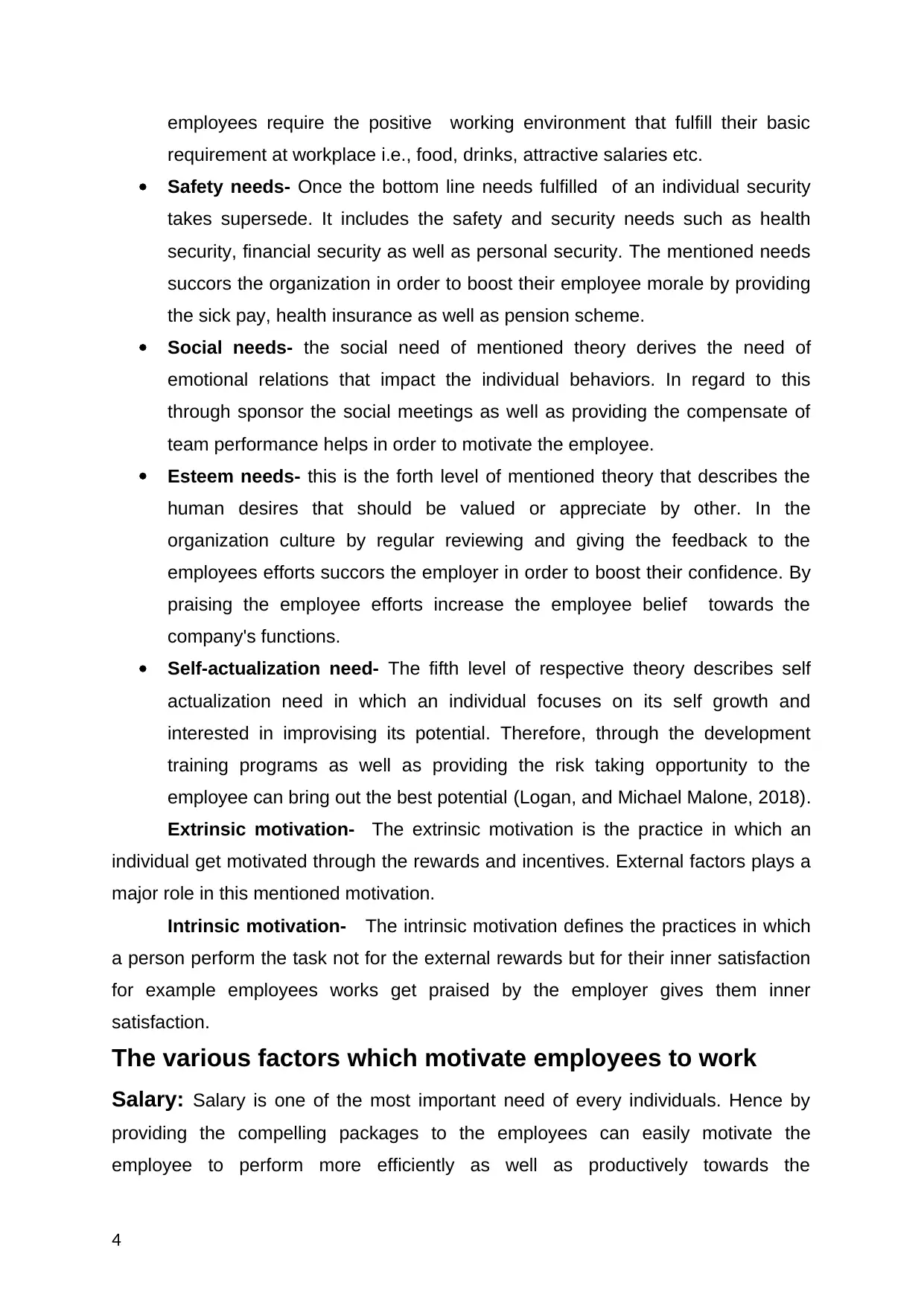
employees require the positive working environment that fulfill their basic
requirement at workplace i.e., food, drinks, attractive salaries etc.
Safety needs- Once the bottom line needs fulfilled of an individual security
takes supersede. It includes the safety and security needs such as health
security, financial security as well as personal security. The mentioned needs
succors the organization in order to boost their employee morale by providing
the sick pay, health insurance as well as pension scheme.
Social needs- the social need of mentioned theory derives the need of
emotional relations that impact the individual behaviors. In regard to this
through sponsor the social meetings as well as providing the compensate of
team performance helps in order to motivate the employee.
Esteem needs- this is the forth level of mentioned theory that describes the
human desires that should be valued or appreciate by other. In the
organization culture by regular reviewing and giving the feedback to the
employees efforts succors the employer in order to boost their confidence. By
praising the employee efforts increase the employee belief towards the
company's functions.
Self-actualization need- The fifth level of respective theory describes self
actualization need in which an individual focuses on its self growth and
interested in improvising its potential. Therefore, through the development
training programs as well as providing the risk taking opportunity to the
employee can bring out the best potential (Logan, and Michael Malone, 2018).
Extrinsic motivation- The extrinsic motivation is the practice in which an
individual get motivated through the rewards and incentives. External factors plays a
major role in this mentioned motivation.
Intrinsic motivation- The intrinsic motivation defines the practices in which
a person perform the task not for the external rewards but for their inner satisfaction
for example employees works get praised by the employer gives them inner
satisfaction.
The various factors which motivate employees to work
Salary: Salary is one of the most important need of every individuals. Hence by
providing the compelling packages to the employees can easily motivate the
employee to perform more efficiently as well as productively towards the
4
requirement at workplace i.e., food, drinks, attractive salaries etc.
Safety needs- Once the bottom line needs fulfilled of an individual security
takes supersede. It includes the safety and security needs such as health
security, financial security as well as personal security. The mentioned needs
succors the organization in order to boost their employee morale by providing
the sick pay, health insurance as well as pension scheme.
Social needs- the social need of mentioned theory derives the need of
emotional relations that impact the individual behaviors. In regard to this
through sponsor the social meetings as well as providing the compensate of
team performance helps in order to motivate the employee.
Esteem needs- this is the forth level of mentioned theory that describes the
human desires that should be valued or appreciate by other. In the
organization culture by regular reviewing and giving the feedback to the
employees efforts succors the employer in order to boost their confidence. By
praising the employee efforts increase the employee belief towards the
company's functions.
Self-actualization need- The fifth level of respective theory describes self
actualization need in which an individual focuses on its self growth and
interested in improvising its potential. Therefore, through the development
training programs as well as providing the risk taking opportunity to the
employee can bring out the best potential (Logan, and Michael Malone, 2018).
Extrinsic motivation- The extrinsic motivation is the practice in which an
individual get motivated through the rewards and incentives. External factors plays a
major role in this mentioned motivation.
Intrinsic motivation- The intrinsic motivation defines the practices in which
a person perform the task not for the external rewards but for their inner satisfaction
for example employees works get praised by the employer gives them inner
satisfaction.
The various factors which motivate employees to work
Salary: Salary is one of the most important need of every individuals. Hence by
providing the compelling packages to the employees can easily motivate the
employee to perform more efficiently as well as productively towards the
4
Paraphrase This Document
Need a fresh take? Get an instant paraphrase of this document with our AI Paraphraser
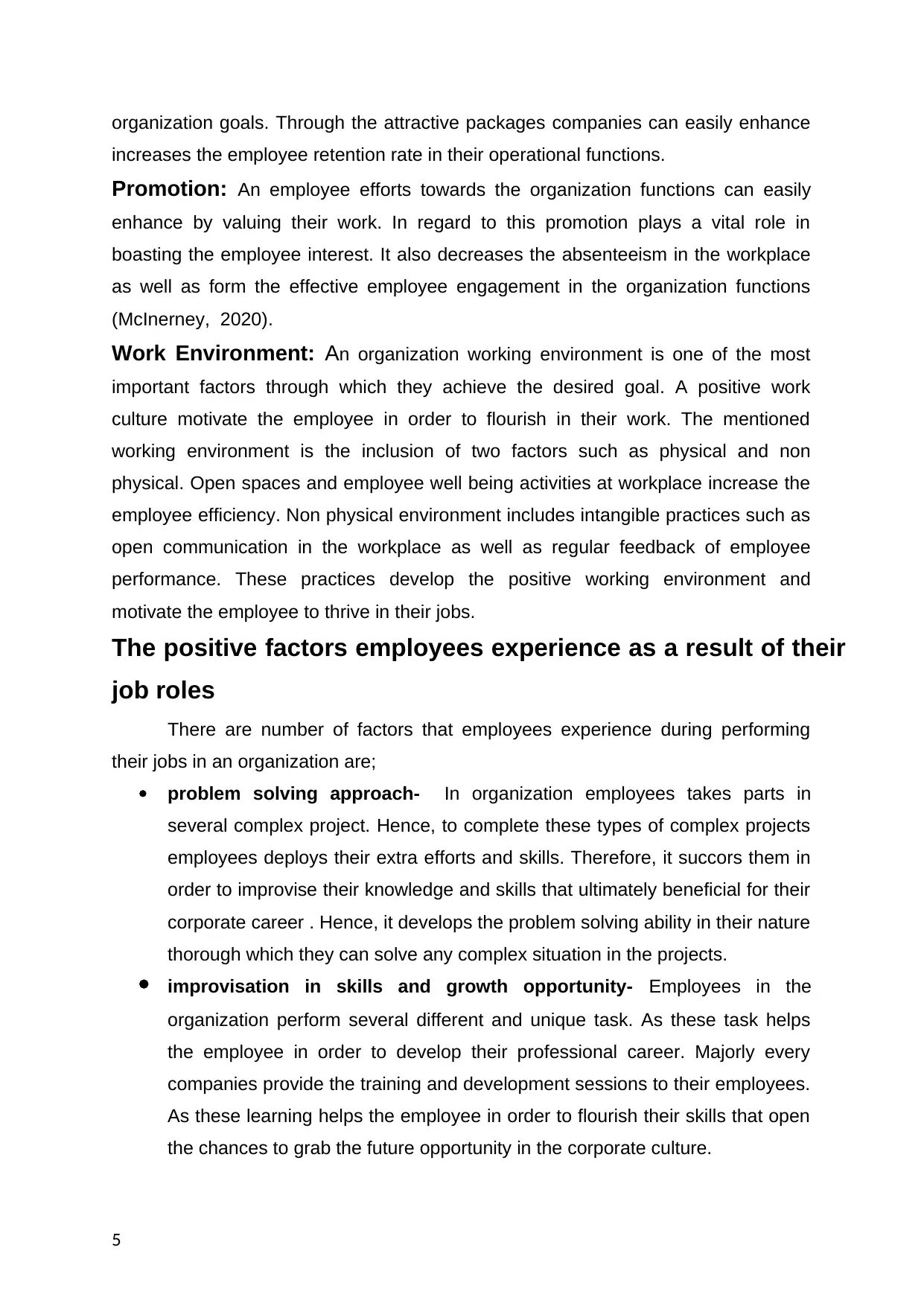
organization goals. Through the attractive packages companies can easily enhance
increases the employee retention rate in their operational functions.
Promotion: An employee efforts towards the organization functions can easily
enhance by valuing their work. In regard to this promotion plays a vital role in
boasting the employee interest. It also decreases the absenteeism in the workplace
as well as form the effective employee engagement in the organization functions
(McInerney, 2020).
Work Environment: An organization working environment is one of the most
important factors through which they achieve the desired goal. A positive work
culture motivate the employee in order to flourish in their work. The mentioned
working environment is the inclusion of two factors such as physical and non
physical. Open spaces and employee well being activities at workplace increase the
employee efficiency. Non physical environment includes intangible practices such as
open communication in the workplace as well as regular feedback of employee
performance. These practices develop the positive working environment and
motivate the employee to thrive in their jobs.
The positive factors employees experience as a result of their
job roles
There are number of factors that employees experience during performing
their jobs in an organization are;
problem solving approach- In organization employees takes parts in
several complex project. Hence, to complete these types of complex projects
employees deploys their extra efforts and skills. Therefore, it succors them in
order to improvise their knowledge and skills that ultimately beneficial for their
corporate career . Hence, it develops the problem solving ability in their nature
thorough which they can solve any complex situation in the projects.
improvisation in skills and growth opportunity- Employees in the
organization perform several different and unique task. As these task helps
the employee in order to develop their professional career. Majorly every
companies provide the training and development sessions to their employees.
As these learning helps the employee in order to flourish their skills that open
the chances to grab the future opportunity in the corporate culture.
5
increases the employee retention rate in their operational functions.
Promotion: An employee efforts towards the organization functions can easily
enhance by valuing their work. In regard to this promotion plays a vital role in
boasting the employee interest. It also decreases the absenteeism in the workplace
as well as form the effective employee engagement in the organization functions
(McInerney, 2020).
Work Environment: An organization working environment is one of the most
important factors through which they achieve the desired goal. A positive work
culture motivate the employee in order to flourish in their work. The mentioned
working environment is the inclusion of two factors such as physical and non
physical. Open spaces and employee well being activities at workplace increase the
employee efficiency. Non physical environment includes intangible practices such as
open communication in the workplace as well as regular feedback of employee
performance. These practices develop the positive working environment and
motivate the employee to thrive in their jobs.
The positive factors employees experience as a result of their
job roles
There are number of factors that employees experience during performing
their jobs in an organization are;
problem solving approach- In organization employees takes parts in
several complex project. Hence, to complete these types of complex projects
employees deploys their extra efforts and skills. Therefore, it succors them in
order to improvise their knowledge and skills that ultimately beneficial for their
corporate career . Hence, it develops the problem solving ability in their nature
thorough which they can solve any complex situation in the projects.
improvisation in skills and growth opportunity- Employees in the
organization perform several different and unique task. As these task helps
the employee in order to develop their professional career. Majorly every
companies provide the training and development sessions to their employees.
As these learning helps the employee in order to flourish their skills that open
the chances to grab the future opportunity in the corporate culture.
5
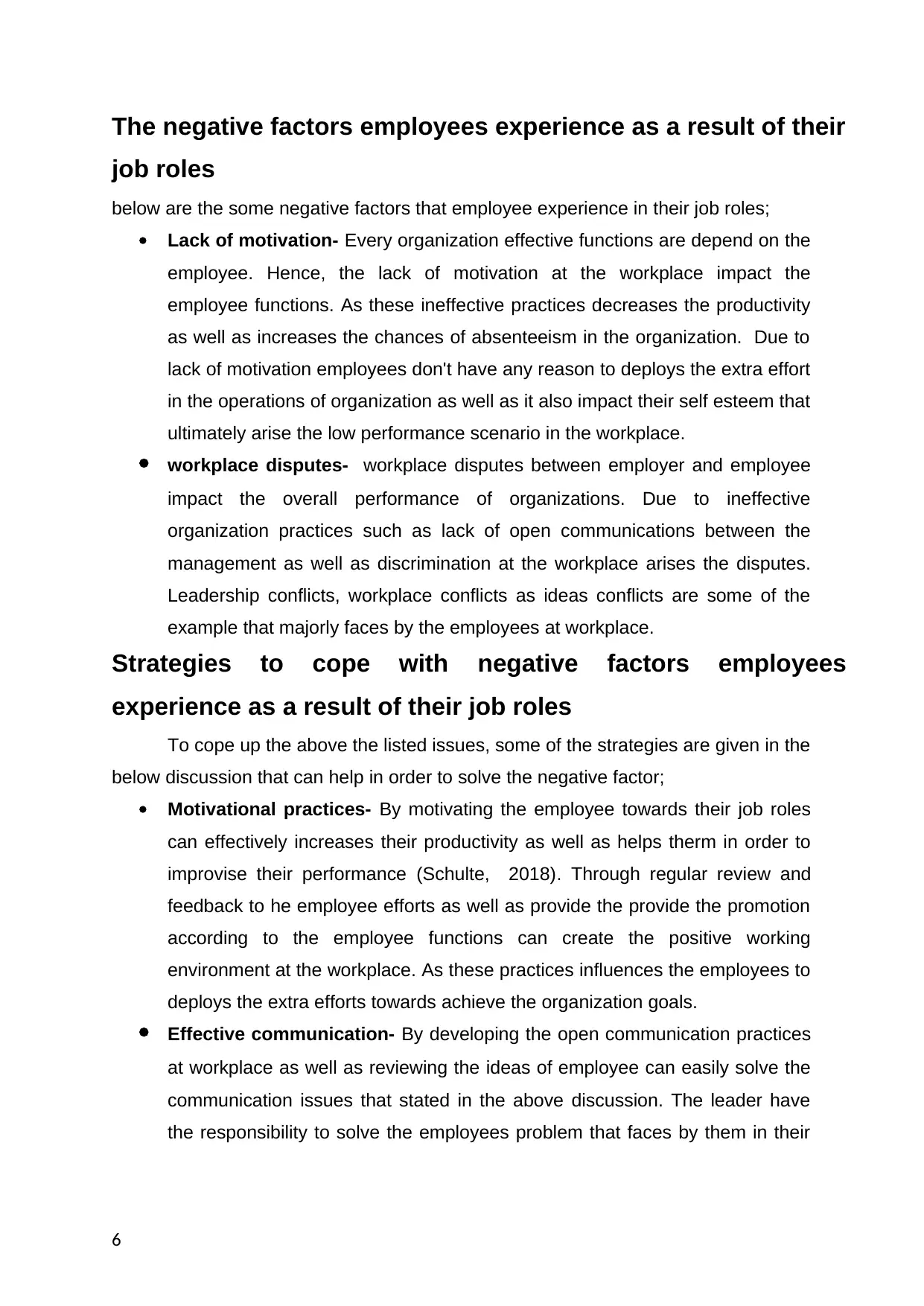
The negative factors employees experience as a result of their
job roles
below are the some negative factors that employee experience in their job roles;
Lack of motivation- Every organization effective functions are depend on the
employee. Hence, the lack of motivation at the workplace impact the
employee functions. As these ineffective practices decreases the productivity
as well as increases the chances of absenteeism in the organization. Due to
lack of motivation employees don't have any reason to deploys the extra effort
in the operations of organization as well as it also impact their self esteem that
ultimately arise the low performance scenario in the workplace.
workplace disputes- workplace disputes between employer and employee
impact the overall performance of organizations. Due to ineffective
organization practices such as lack of open communications between the
management as well as discrimination at the workplace arises the disputes.
Leadership conflicts, workplace conflicts as ideas conflicts are some of the
example that majorly faces by the employees at workplace.
Strategies to cope with negative factors employees
experience as a result of their job roles
To cope up the above the listed issues, some of the strategies are given in the
below discussion that can help in order to solve the negative factor;
Motivational practices- By motivating the employee towards their job roles
can effectively increases their productivity as well as helps therm in order to
improvise their performance (Schulte, 2018). Through regular review and
feedback to he employee efforts as well as provide the provide the promotion
according to the employee functions can create the positive working
environment at the workplace. As these practices influences the employees to
deploys the extra efforts towards achieve the organization goals.
Effective communication- By developing the open communication practices
at workplace as well as reviewing the ideas of employee can easily solve the
communication issues that stated in the above discussion. The leader have
the responsibility to solve the employees problem that faces by them in their
6
job roles
below are the some negative factors that employee experience in their job roles;
Lack of motivation- Every organization effective functions are depend on the
employee. Hence, the lack of motivation at the workplace impact the
employee functions. As these ineffective practices decreases the productivity
as well as increases the chances of absenteeism in the organization. Due to
lack of motivation employees don't have any reason to deploys the extra effort
in the operations of organization as well as it also impact their self esteem that
ultimately arise the low performance scenario in the workplace.
workplace disputes- workplace disputes between employer and employee
impact the overall performance of organizations. Due to ineffective
organization practices such as lack of open communications between the
management as well as discrimination at the workplace arises the disputes.
Leadership conflicts, workplace conflicts as ideas conflicts are some of the
example that majorly faces by the employees at workplace.
Strategies to cope with negative factors employees
experience as a result of their job roles
To cope up the above the listed issues, some of the strategies are given in the
below discussion that can help in order to solve the negative factor;
Motivational practices- By motivating the employee towards their job roles
can effectively increases their productivity as well as helps therm in order to
improvise their performance (Schulte, 2018). Through regular review and
feedback to he employee efforts as well as provide the provide the promotion
according to the employee functions can create the positive working
environment at the workplace. As these practices influences the employees to
deploys the extra efforts towards achieve the organization goals.
Effective communication- By developing the open communication practices
at workplace as well as reviewing the ideas of employee can easily solve the
communication issues that stated in the above discussion. The leader have
the responsibility to solve the employees problem that faces by them in their
6
⊘ This is a preview!⊘
Do you want full access?
Subscribe today to unlock all pages.

Trusted by 1+ million students worldwide
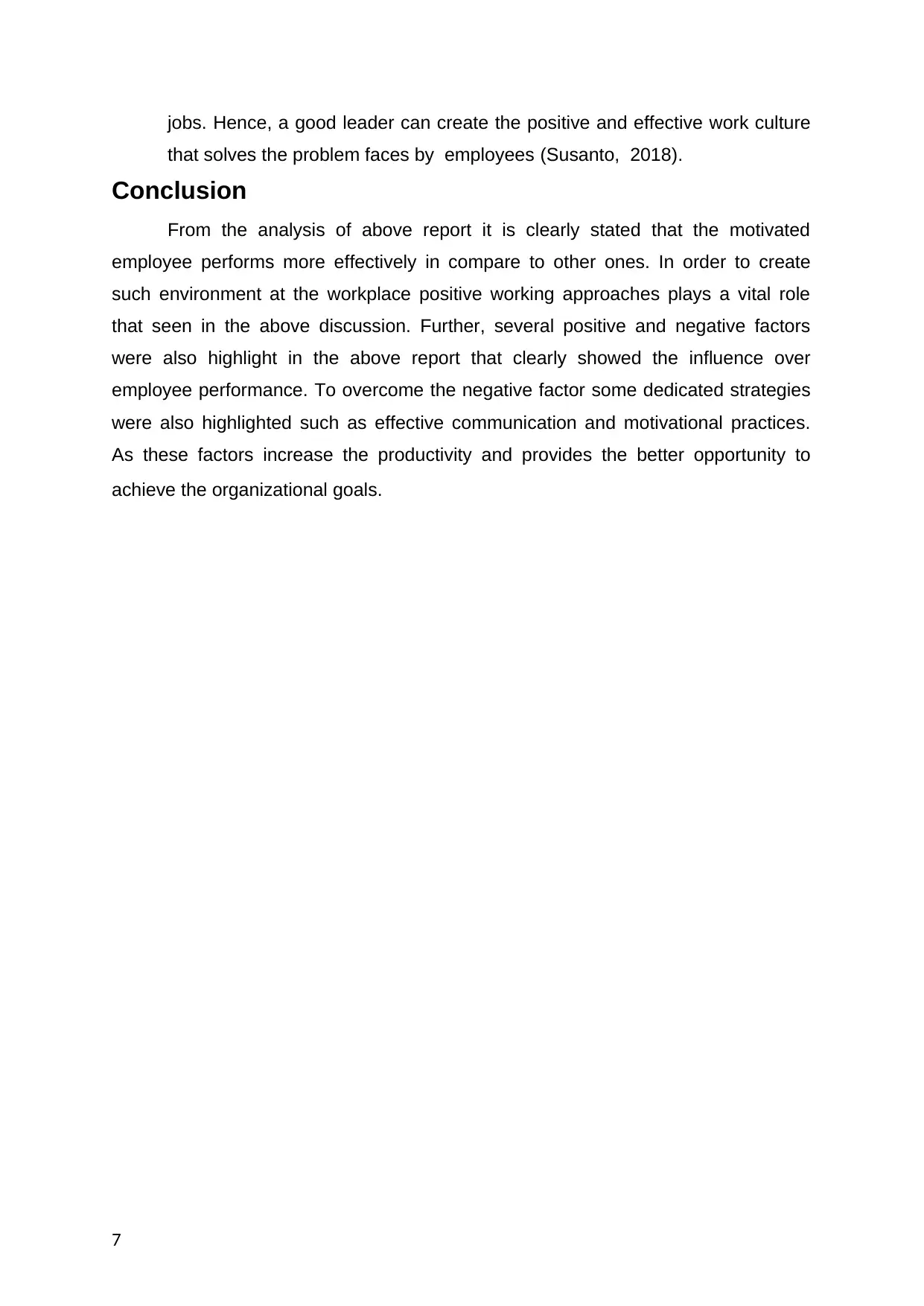
jobs. Hence, a good leader can create the positive and effective work culture
that solves the problem faces by employees (Susanto, 2018).
Conclusion
From the analysis of above report it is clearly stated that the motivated
employee performs more effectively in compare to other ones. In order to create
such environment at the workplace positive working approaches plays a vital role
that seen in the above discussion. Further, several positive and negative factors
were also highlight in the above report that clearly showed the influence over
employee performance. To overcome the negative factor some dedicated strategies
were also highlighted such as effective communication and motivational practices.
As these factors increase the productivity and provides the better opportunity to
achieve the organizational goals.
7
that solves the problem faces by employees (Susanto, 2018).
Conclusion
From the analysis of above report it is clearly stated that the motivated
employee performs more effectively in compare to other ones. In order to create
such environment at the workplace positive working approaches plays a vital role
that seen in the above discussion. Further, several positive and negative factors
were also highlight in the above report that clearly showed the influence over
employee performance. To overcome the negative factor some dedicated strategies
were also highlighted such as effective communication and motivational practices.
As these factors increase the productivity and provides the better opportunity to
achieve the organizational goals.
7
Paraphrase This Document
Need a fresh take? Get an instant paraphrase of this document with our AI Paraphraser
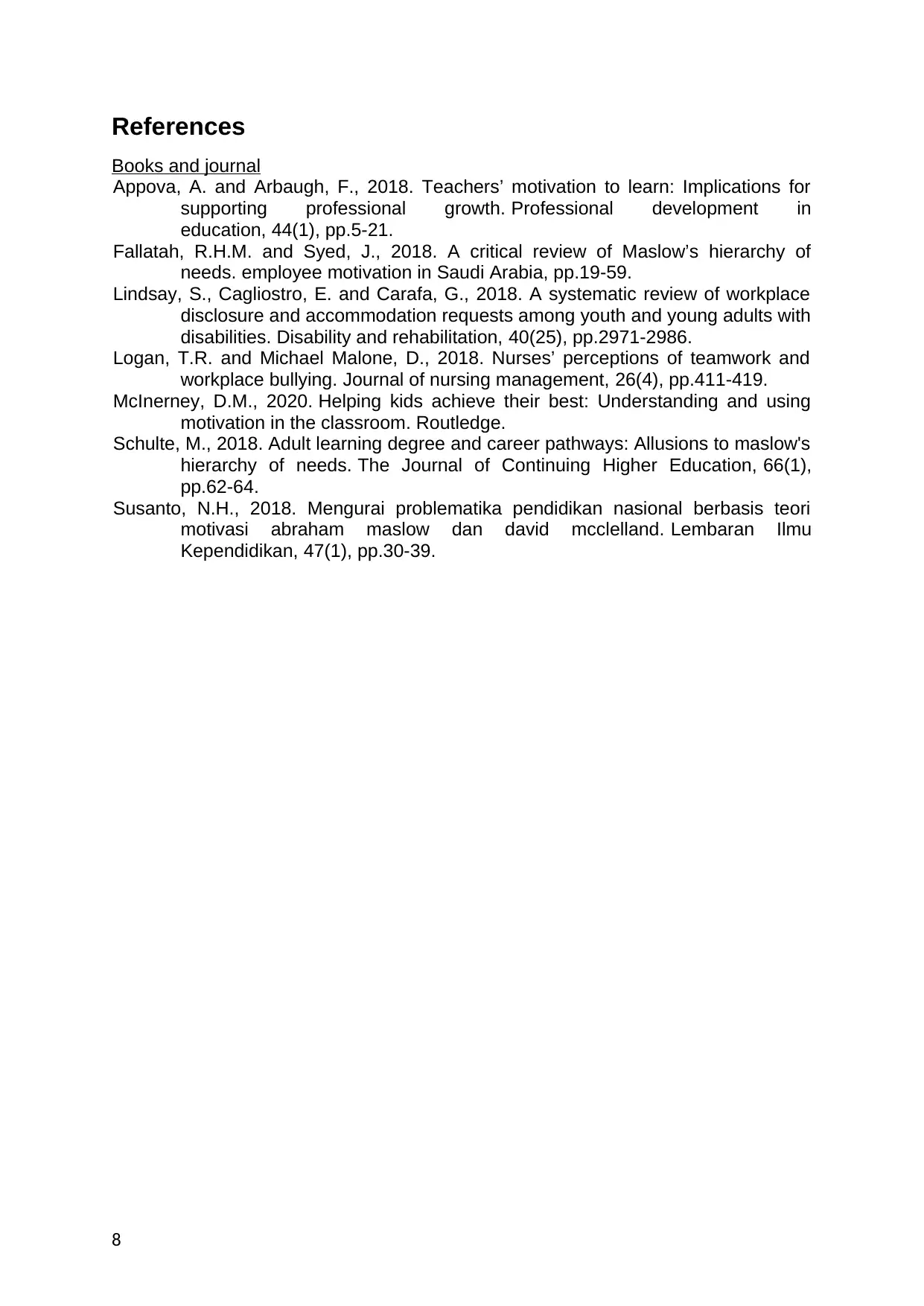
References
Books and journal
Appova, A. and Arbaugh, F., 2018. Teachers’ motivation to learn: Implications for
supporting professional growth. Professional development in
education, 44(1), pp.5-21.
Fallatah, R.H.M. and Syed, J., 2018. A critical review of Maslow’s hierarchy of
needs. employee motivation in Saudi Arabia, pp.19-59.
Lindsay, S., Cagliostro, E. and Carafa, G., 2018. A systematic review of workplace
disclosure and accommodation requests among youth and young adults with
disabilities. Disability and rehabilitation, 40(25), pp.2971-2986.
Logan, T.R. and Michael Malone, D., 2018. Nurses’ perceptions of teamwork and
workplace bullying. Journal of nursing management, 26(4), pp.411-419.
McInerney, D.M., 2020. Helping kids achieve their best: Understanding and using
motivation in the classroom. Routledge.
Schulte, M., 2018. Adult learning degree and career pathways: Allusions to maslow's
hierarchy of needs. The Journal of Continuing Higher Education, 66(1),
pp.62-64.
Susanto, N.H., 2018. Mengurai problematika pendidikan nasional berbasis teori
motivasi abraham maslow dan david mcclelland. Lembaran Ilmu
Kependidikan, 47(1), pp.30-39.
8
Books and journal
Appova, A. and Arbaugh, F., 2018. Teachers’ motivation to learn: Implications for
supporting professional growth. Professional development in
education, 44(1), pp.5-21.
Fallatah, R.H.M. and Syed, J., 2018. A critical review of Maslow’s hierarchy of
needs. employee motivation in Saudi Arabia, pp.19-59.
Lindsay, S., Cagliostro, E. and Carafa, G., 2018. A systematic review of workplace
disclosure and accommodation requests among youth and young adults with
disabilities. Disability and rehabilitation, 40(25), pp.2971-2986.
Logan, T.R. and Michael Malone, D., 2018. Nurses’ perceptions of teamwork and
workplace bullying. Journal of nursing management, 26(4), pp.411-419.
McInerney, D.M., 2020. Helping kids achieve their best: Understanding and using
motivation in the classroom. Routledge.
Schulte, M., 2018. Adult learning degree and career pathways: Allusions to maslow's
hierarchy of needs. The Journal of Continuing Higher Education, 66(1),
pp.62-64.
Susanto, N.H., 2018. Mengurai problematika pendidikan nasional berbasis teori
motivasi abraham maslow dan david mcclelland. Lembaran Ilmu
Kependidikan, 47(1), pp.30-39.
8
1 out of 8
Related Documents
Your All-in-One AI-Powered Toolkit for Academic Success.
+13062052269
info@desklib.com
Available 24*7 on WhatsApp / Email
![[object Object]](/_next/static/media/star-bottom.7253800d.svg)
Unlock your academic potential
Copyright © 2020–2025 A2Z Services. All Rights Reserved. Developed and managed by ZUCOL.

